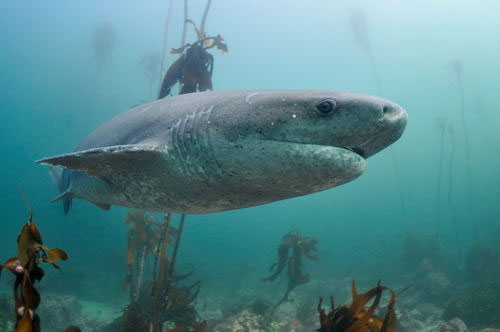Named for their sturdy appearance and aggressive reputation, the bull shark is one of the most common large sharks around the world. Despite being primarily a marine species, it is known for his penchant for fresh water and can often be located in rivers, estuaries and even in some lakes in Central America. The bull shark has also been found about 3,000 kilometers upstream in rivers such as the Amazon and the Mississippi.
Hammerhead shark
Perhaps the most characteristic of all species of sharks, hammerheads is easily recognized by the particular shape of his head. Worldwide are about 10 species of them, some of which grow up to 6 meters long and are known to attack humans.
Blue Shark
Blue sharks are among the most common sharks and those who take great diversity of territories; They can be commonly seen both in ocean waters as well as occasionally on the coast. Known for its extraordinary migratory abilities, some of them have come to swim thousands of kilometers between continents in just a few months.
Tiger shark
As fearsome as the name suggests, tiger sharks are rightly respected for its aggressive nature and its astonishing predatory abilities. Baptized with that name by the patterns on their skin, these sharks are by far the most numerous members of his immediate family.
White shark
It is hard to overestimate the reputation of the great and majestic white shark. One of the great ocean predators, is the most easily identifiable shark in the world, thanks to its distinctive and beautiful color, black eyes and ferocious teeth and jaw, which for decades have graced many magazine covers.
The white shark is one of the most widely distributed sharks has, thanks to its unusual ability to maintain the temperature of his body higher than the surrounding environment, allowing it to survive happily in very cold water.
Basking Shark
Second in size only to the whale shark, basking sharks are huge creatures whose size is more surprising when you consider that only eat plankton. Usually they swim with their huge mouths open width, filtering tiny food particles as the water passes.
Tiburon wide mouth
The Wide Mouth Shark is one of the most strange and mysterious family of sharks members. Only 22 specimens have been reported since it was captured and first described in 1976. Many of the details of his life are still unknown.
Whale shark
The largest of all sharks and the largest fish, the whale shark is one of the most dramatic ocean views. Its large size, their distinctive patterns and its enormous frontal mouth make it instantly recognizable and can be commonly seen wandering near the surface in tropical and subtropical waters around the world.
Shark Sierra
The saw sharks are among the most distinctive species of shark, with its snout that resembles a saw (called face) embedded with teeth. This curious adaptation is effective, as these sharks use it to remove the muddy or sandy bottom as they seek their prey, which stuns with sudden movements of your saw. The saw shark is the only shark apart from shark eel having six gills, instead of the five or seven usually having another.
Cow shark
The cow shark is the most famous family member. Unlike their closest relatives, who tend to live in deep water, the Shark Cow prefers coastal waters. An indiscriminate carrion eater, eats everything from bodies of other fish, sharks and seals and can behave aggressively towards swimmers and divers.
